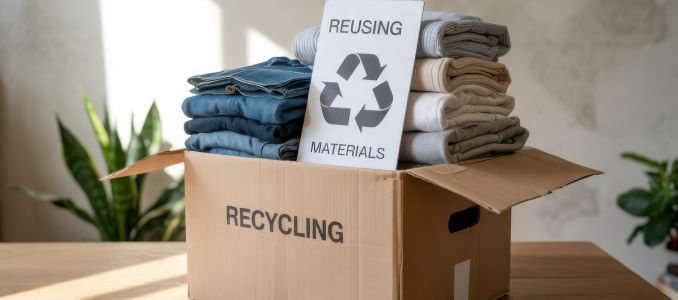
Extend, Reuse, Protect: The Power of Recommerce
Recommerce helps protect the environment by cutting waste, conserving resources, and reducing carbon emissions.
- By James Murdock
- Apr 29, 2025
Sustainable infrastructure is emphasized as a global priority. That means businesses must begin reevaluating operations and designing systems that tackle waste while embedding profitability and sustainability at their core.
One model that addresses both needs is recommerce.
Recommerce as the Solution
Recommerce is the practice of reselling previously owned or used products. It is part of the circular economy and extends product lifecycles through refurbishment and resale.
The most popular recommerce model is the trade-in program, where customers return their old products for a discount on a new one. Online marketplaces dedicated to refurbished goods have also grown significantly and increasingly offer a trade-in element. Another approach is the Device-as-a-Service model, a type of leasing where customers rent devices for a period and return them for renewal or upgrade. These models encourage longer product lifespans by diverting products from landfills to other buyers or users.
Technology provides a clear example of recommerce benefits, as electronic waste (e-waste) has surged by 82% since 2010, although this figure is contextualized by the purchase of roughly 2 billion smartphones annually. Manufacturing a new smartphone produces approximately 72 kilograms of carbon dioxide, while refurbishing and reselling one generates only about 11 kilograms. Choosing a refurbished smartphone over a new one saves about 64 kilograms of CO2 emissions, conserves approximately 244 kilograms of raw materials, prevents the use of 76,000 liters of water per device, and avoids contributing 200 grams of e-waste to landfills.
Speaking the language of business is important when discussing sustainable solutions. Recommerce also presents clear business benefits, making it a more practical model compared to others.
Aligns with ESG Goals
When companies refurbish and resell products, they reduce demand for raw materials and lower the carbon footprint associated with manufacturing new goods. This strategy supports environmental, social, and governance (ESG) goals—a priority for many business leaders.
Encourages Customer Loyalty
Recommerce opens new revenue streams by tapping into the rapidly growing secondary market. It fosters customer loyalty by encouraging consumers to stay within a company's ecosystem, whether by receiving discounts on trade-ins or by purchasing older models at more affordable prices. It can also attract new customers—those who seek quality brands without needing the latest model.
Protects the Residual Value of Older Products
Companies that manage their recommerce operations stabilize the prices of their older products, reinforcing their reputation for producing desirable goods. The technology industry exemplifies this, as many leading electronics manufacturers and retailers offer trade-in programs that help maintain strong residual values across independent marketplaces.
Consumer Benefits and Challenges
For consumers, the benefits of refurbished products are straightforward. These products are often 20–60% cheaper than new models, typically include warranties and return policies comparable to new items, and allow buyers to reduce their carbon footprint.
While skepticism regarding second-hand products is improving, recommerce programs should continue to emphasize product quality, sustainability, and cost benefits. A successful recommerce model requires both a high-quality product and an excellent customer experience.
Building and Scaling Successful Recommerce Operations
Developing a recommerce model requires a comprehensive overhaul of traditional manufacturing and sales processes, which often focus solely on product distribution rather than recovery.
Consider Returns Processes
Streamlining the reverse logistics process is critical to getting products back into consumers’ hands. Many companies lack sophisticated systems for returns, creating opportunities for those who can optimize this function. However, building this infrastructure is complex.
Build a Grading System
Reliable grading systems for refurbished products are essential to reassure buyers about quality and performance. Partnerships with certification bodies can support independent verification of product standards.
Warranties Comparable to New Products
Offering warranties that mirror those provided with new products helps reassure buyers. Additionally, clear return policies, after-sales support, and repair services are important to a successful recommerce operation.
Limit Flash Sales
Brands should limit flash sales, as frequent discounts undermine trade-in programs and recommerce initiatives. Companies without frequent sales typically maintain stronger brand equity and better residual values for older models.
Many businesses opt to outsource recommerce operations to specialist partners who possess the necessary infrastructure and expertise. These partnerships allow companies to maintain a focus on their core business while ensuring their circular programs are efficient, profitable, and aligned with brand standards.
A Practical and Profitable Solution
Protecting the planet requires a reevaluation of consumption patterns and a shift toward sustainable production, use, and disposal practices. Transitioning to a circular economy offers practical, profitable solutions that benefit both businesses and consumers.
About the Author
James is Co-founder and Chief Marketing Officer of Alchemy, the world’s fastest-growing circular technology company. With over 20 years of experience delivering marketing and business operations across leading tech markets, he is a leader in driving innovative solutions to reduce e-waste and carbon emissions. Since co-founding Alchemy in 2017, James has been instrumental in transforming the tech industry’s approach to sustainability. Under his leadership, Alchemy has refurbished and resold more than 9 million devices, saving over 540 million kilograms in carbon emissions. He strives to empower businesses and consumers to reduce their carbon footprint and embrace circularity. As the first and only company certifying CO2 savings for refurbished tech, Alchemy leads the charge in democratizing access to sustainable tech choices. James is passionate about creating impactful change, and he continues to lead Alchemy’s mission to normalize sustainable technology and pave the way for a greener future.